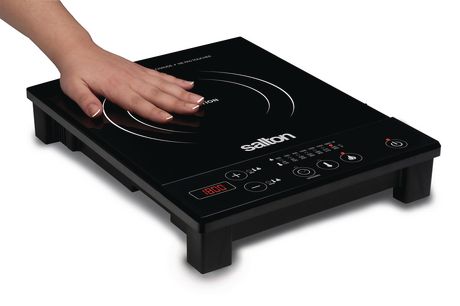Our site contains ads and uses Amazon affiliate links. We may earn a small commission at no extra cost to you. We know ads can be distracting, and we’re sorry for any inconvenience they cause. It helps us keep the site running. Thanks for your understanding and supporting us!
In induction cooking, one of all-important question: how to clean Induction Cooktop? You know the drill. You’ve just whipped up a culinary masterpiece, and now you’re staring at a less-than-pristine cooktop. Don’t sweat it! I’ve got your back.
Induction cooktops are the most desired kitchen appliance for their elegant design and ease of use. A clean and shiny stove is always a welcome place for cookware to prepare tasty food. After cooking, it is necessary to clean induction cooktop properly.
But the devices are well known for being frustrating to clean up. For instance, if a bit of oil splashes on the glass top and is not cleaned immediately, it will convert into a black burn; if a drop of tomato sauce falls on it, a bad stain will be created.
Trust me, if you are a busy mom or working person, keeping your induction cooktop sparkling isn’t rocket science. It’s all about the right techniques and a little TLC.
I’m going to suggest you some ways to clean induction cooktop. But before I advice some tips, please read the user manual of your device and know what has been referred to cleaning.
If you have no idea about the manufacturer’s cleaning process, some of my tips may cause harm instead of well being of your cooktop.
Ways and Tips to Clean Induction Cooktop

Clean up Immediately
Some types of stains are too hard to remove from the glass top of the stove. Such as tomato sauce, soup etc. It is usual that you will feel lazy and leave the cleaning up process for the next day. But this will ruin your induction stove. Reheating stains will complicate clean induction cooktop and also waste a lot of money.
Food should be cleaned up from the stove as soon as possible after the cooktop cools down. But some types of food products are really very bad. For example, jelly, syrup, sugar can enter into the glass top which can cause cracks.
More efforts are required to clean up food which turns hard when dried. Such as, boiled water and tomato sauce. Extra pressures while cleaning the glass top can cause cracks on it.
The warranty does not cover cracked glass tops. So its your responsibility to replace it. If you are keen about cleaning your induction device, you will get a clean, polished cooktop which will serve you for many years.
Use Good Quality Cleaners

There are so many cleansers on the market which are specially for cleaning up induction cooktops. Most of them are not harmful to the device and are thick and creamy.
How to Use Cream Cleaners
- Pour a little liquid cleanser and spread a thin layer upon the surface quickly.
- Wait for a minute. The cleanser will change from liquid to white dry stuff.
- Wipe the glass top with a dry cotton cloth. Extra consideration is required for the areas which are rough.
- When the cleanser is removed, the surface should be wiped again with another piece of dry cloth.
- The cooktop should be felt smooth. If it does not become smooth, keep wiping.
In Case of Hard Stains
Liquid should be applied on the stained area but don’t dry it. The cleanser acts as a lubricant for burnt marks.
Then use a scraper, if you have. Scrap gently the marks until it is fully removed.
Cleaners Which Should Be Avoided
When users face problems with tough stains, especially burnt food, they use cleaners which are based on ammonia. This is because of a logical idea, Windex is a dominating glass cleaner.
Ammonia can clean light stains and finger print but it is not enough powerful to clean remaining burned food particles. When the cooktop is heated up, ammonia may cause multi coloured stains on the glass surface.
While some other users think that ammonia is too weak for cleaning induction stoves. They switch to rough chemical cleansers. For instance, Ajax, Comet and abrasive sponges like as Scotch-Brite. These cleaning materials are too harsh for induction cooktops and they can cause micro scratch marks on the surface.
These scratches cannot be seen immediately, they will appear after a long time which will lead to a visually unattractive surface.
Note: Scrapers made of wool, steel should also never be used as they make scratches on glass. This may cause permanent damage to the cooktop.
Use Razors to Clean Induction Cooktop
Razors are only required to clean induction cooktop if it is suffering from a long-time damage from stains. This is a debated topic. According to some people, bringing a sharp object close to glass may endanger the device. While some people say if it is used very carefully and on tough stains, it will help to keep the stovetop clean.
But the manufacturers advise buying a special kit which includes a cooktop cleaner and some clean up pads.
Add a sufficient amount of cleanser to the stained area and use the scraper to remove tough marks. Move the cutting edge of the knife in a forward backward motion with pressure.
The cutting edge should be placed flat but maintaining contact. Never use the corners of razors because it can create scratch marks on the glass top.
Check Your Store
Though you keep a specialized cleaning kit for your glass cooktop, the solution to emergency stains may be found in your kitchen. Baking soda is one of the best home-made cleaners and it is very cheap too! Lemon juice and vinegar will also work like magic for cleaning tough stains.
While applying baking soda, pour directly on the marks and wait for some time. Then rub the glass surface with a wet piece of cloth, the burnt food will be wiped off. In case of using lemon juice, a quick ingredient mixing is required.
A bottle should be filled with boiled water, then add lemon juice to it. Then apply it on grungy stain and wipe it off with a cotton cloth. Repeat this process as your needs. Finally, again rinse the clean surface and rub it completely dry with another piece of cloth.
Final Thoughts
When the matter of cleaning comes, users may think it is a pain using an induction stove with a glass top. But glass/ceramic cooktops are easy to clean than gas or coil stoves.
The rough surfaces of gas and coil stoves lock out food but the flat and smooth induction devices make clean induction cooktop much easier; only a simple wipe is required.
If you wipe the device after each time after cooking, the heavy-duty work will be at a minimum level. If you follow these steps, you can easily maintain the beauty and functions of the cooktop for a long time.
You May Like to Read





